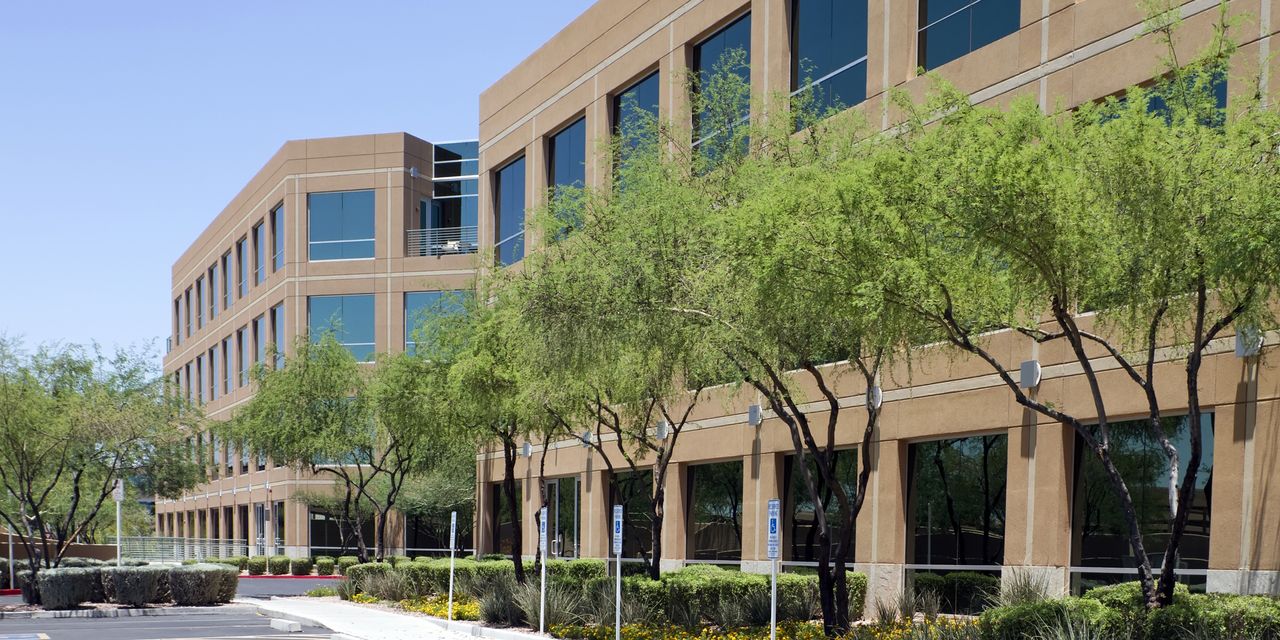Regional banks have received merciless scrutiny since the collapse of Silicon Valley Bank on March 10. Uninsured deposits and cash levels have been weighed—and where they’re found wanting, bank stocks have been cut in half.
The next worry for regional banks could be commercial real estate. Postpandemic changes in how we work and shop are leaving vacancies across the country. If a recession arrives, experts warn, large numbers of property owners could default on their loans.
Which lenders have the most at stake? Banking regulators have set guidelines for concentration in commercial real estate loans, so Barron’s asked S&P Global Markets Intelligence to scour federal filings for banks that exceed those levels. We then focused on the 15 largest banks in that group.
These lenders are mostly midsize banks in the bottom half of the nation’s top 100 in assets. Commercial real estate is their concentration, the banks tell Barron’s, because they’re good at such loans. Judging by their below-industry levels of bad loans, that seemed to be the case at year-end 2022. At 11 of the 15 banks, nonperforming loans amounted to less than half the regional bank median of 0.84% of total loans.
Most say their loans are well covered by the values of the properties—suburban office parks, retail locations, apartment buildings, and more. But if the foundations crack under commercial property in the coming year, investors will want to keep an eye on these and other local banks. In all, regional and community banks account for an estimated 80% of commercial real estate lending.
Some names on our list are familiar from recent headlines. The second-largest bank on the list is Pacific Western Bank. The shares of its Beverly Hills, Calif.–based holding company,
PacWest Bancorp
(ticker: PACW), skidded wildly after its venture-backed depositors pulled cash in the wake of Silicon Valley Bank’s collapse. PacWest lined up funding and says it has more than enough cash to cover uninsured deposits. Its loans are diversified and in good shape, it says.
PacWest’s loans include many for real estate. At the end of 2022, commercial real estate loans amounted to more than 375% of Pacific Western’s capital, its cushion for loan losses. The riskiest kind of real estate loans—for land and construction—came to almost 140% of the bank’s capital.
Federal guidelines define two tests that may prompt regulators to further analyze “the level, nature, and management” of a bank’s commercial real estate concentration risk. The first test is whether loans for non-owner-occupied commercial real estate exceed 300% of a bank’s capital and have grown more than 50% in the past 36 months. The second test is whether loans for construction and land development exceed 100% of capital.
| Company / Ticker | Recent Price | Year-to-Date Change | Market Value (bil) | Total Assets (bil) | CRE/Capital > 300% | CRE Growth >50% in 36 mos. | C&D/Capital > 100% | Non-Performing Loans/Total Loans % |
|---|---|---|---|---|---|---|---|---|
| Valley National Bancorp / VLY | $9.31 | -17.7% | $4.7 | $57.5 | 440 | 73 | 64 | 0.63 |
| PacWest Bancorp / PACW | 9.39 | -59.1 | 1.1 | 41.2 | 376 | 36 | 137 | 0.38 |
| Bank OZK / OZK | 34.52 | -13.8 | 4.0 | 27.7 | 346 | 43 | 187 | 0.24 |
| Pacific Premier Bancorp / PPBI | 24.51 | -22.3 | 2.3 | 21.7 | 329 | 110 | 15 | 0.21 |
| Washington Federal / WAFD | 30.34 | -9.6 | 2.0 | 21.6 | 393 | 84 | 121 | 0.17 |
| Independent Bank / INDB | 67.38 | -20.2 | 3.0 | 19.3 | 316 | 100 | 52 | 0.39 |
| Trustmark / TRMK | 25.31 | -27.5 | 1.5 | 18.0 | 271 | 33 | 106 | 0.97 |
| Axos Financial / AX | 37.64 | -1.5 | 2.3 | 17.9 | 422 | 110 | 154 | 0.61 |
| ServisFirst Bancshares / SFBS | 55.06 | -20.1 | 3.0 | 14.6 | 329 | 129 | 100 | 0.15 |
| First United / FUNC | 17.08 | -13.1 | 0.1 | 14.5 | 343 | 80 | 161 | 0.30 |
| Sandy Spring Bancorp / SASR | 26.77 | -24.0 | 1.2 | 13.8 | 369 | 114 | 83 | 0.31 |
| Provident Financial Services / PFS | 19.50 | -8.7 | 1.5 | 13.8 | 487 | 52 | 57 | 0.57 |
| Dime Community Bancshares / DCOM | 23.46 | -26.3 | 0.9 | 13.2 | 563 | 294 | 17 | 0.32 |
| First Foundation / FFWM | 7.48 | -47.8 | 0.4 | 13.0 | 561 | 100 | 13 | 0.12 |
| OceanFirst Financial / OCFC | 19.04 | -10.4 | 1.1 | 13.0 | 449 | 142 | 53 | 0.23 |
| MEDIAN FOR REGIONAL BANKS | 124 | 41 | 29 | 0.84 |
Note: “Capital” means equity, reserves, and allowance for loan losses; “nonperforming” means loans 90+ days past due or nonaccruing; market data as of March 28; other data as of Dec. 31, 2022.
Sources: S&P Global Market Intelligence; Bloomberg; FFEIC
Like all the banks we list here, PacWest exceeded the level of one or both of these “300/100” tests.
Commercial real estate loans are often a leading indicator in a downturn, when speculative land loans are some of the first assets to run into trouble, says banking consultant Kathryn Dick, who was deputy comptroller at the Office of the Comptroller of the Currency in 2006 when the loan concentration guidelines were developed.
“The crux of that guidance is to have a trigger point for a conversation with the regulators,” says Dick. “It was issued as guidance, not a hard-wired limit, because at many community banks, this is their bread and butter.”
PacWest didn’t respond to questions from Barron’s. But when PacWest reported 2022 earnings in January, Chief Executive Paul Taylor expected its “relationship” real estate lending would continue. “As you look at our balance sheet,” he told conference-call listeners, “one thing we do very well, and a lot of, is real estate.” At year end, the bank’s nonperforming loans—including loans past due by 90 days or more—were just 0.38% of total loans.
The largest lender with commercial real estate loans above the guidelines in December was Valley National Bancorp (VLY), a New York and New Jersey–focused lender whose commercial real-estate loan level was 440% of capital, after rising more than 70% in the prior three years.
Senior Vice President Marc Piro says that two acquisitions contributed to Valley’s growth. The bank’s commercial real estate loans are “highly diversified by region, property type, and loan size,” Piro writes. “We hold a highly granular portfolio with no significant concentrations in any specific area and continue to maintain exceptional credit quality.”
The third-largest bank with high concentration levels is
Bank OZK
(OZK), a Little Rock, Ark.–based lender whose commercial real estate loans topped 345% of capital in December, with construction and development loans topping 180% of capital. Saying it is in its quiet period, OZK wouldn’t comment on its loans. In its 10-K filed with the Securities and Exchange Commission in February, the bank acknowledged the lending concentration but said it has established appropriate underwriting and monitoring procedures for the loans. At year end, its common equity was among the highest of the banks on our list, at 14% of assets.
No. 4 on our list of concentrated lenders is
Pacific Premier Bancorp
(PPBI), an Irvine, Calif.–based bank whose commercial real estate loans more than doubled over the three years ended December 2022, to a level of 329% of its capital. Two-thirds of those loans were for multifamily residential buildings, says a spokesman, and they have performed well.
“These [commercial real estate] loan concentrations have been well-managed through various economic and interest rate cycles,” he writes. “We have longstanding, disciplined credit underwriting standards.”
The shares of
Washington Federal
(WAFD) have held up better than most on the list. That’s because the Seattle-based bank’s loans are secured by commercial properties worth twice the loan amounts, says marketing chief Brad Goode. “Our nonperforming assets are one of the lowest among regional banks,” he says.
Real estate lending can be a profitable source of growth for banks that know their territory. The greater Washington, D.C., base of
Sandy Spring Bancorp
(SASR) has seen powerful growth in housing, offices, and retail for over a decade. The bank’s commercial real estate loans exceeded 360% of capital at December’s end, after doubling over the prior three years. A 2020 acquisition contributed to that growth. In an earnings call in January, CEO Dan Schrider said that retail was the largest piece of its loan portfolio, at about 29%, with another 15% in suburban offices.
“We just keep our loan-to-value ratios very low.”
Almost all the loans in the commercial real estate portfolio of
First Foundation
(FFWM), a Dallas–based lender, are on multifamily residential properties, says CEO Scott Kavanaugh, with the loans averaging a conservative 55% of the properties’ values when made. The bank’s percentage of nonperforming loans is the lowest on the list. “Multifamily is the best asset class in commercial real estate, in terms of default rates,” he says. “We’ve never taken a charge-off in our multifamily loans.”
From its base on New Jersey’s shore,
OceanFirst Financial
(OCFC) makes most of its commercial loans in the region from New York City to Philadelphia. Spokeswoman Jill Apito Hewitt says the bank has a diverse loan portfolio, with few urban offices. Only 0.11% of its commercial real estate loans were nonperforming last year.
Barron’s asked every bank on this list about their lending. All but seven responded.
While the 300/100 tests can lead to conversations about loan concentration, they may also highlight a bank’s expertise. San Diego–based
Axos Financial
(AX) had commercial real estate loans that exceeded 420% of capital at December’s end, with construction and development loans at 110% of its capital.
But Axos shares have dipped the least of all our listed concentrated lenders. The bank has low levels of uninsured deposits and one of the industry’s lowest levels of unrealized losses in its bond portfolio—the two most prominent pain points for regional banks in recent weeks.
Axos also has a distinctive way of real estate lending, in which it takes loan interests that are senior to nonbank lenders such as the Michael Dell family office MSD Partners, with whom the bank helped finance last year’s sale of Donald Trump’s Washington, D.C., hotel. Such arrangements keep Axos’ loans-to-value levels below 50%, so the properties would have to fall by half in value to endanger the collateral.
“We just keep our loan-to-value ratios very low,” says CEO Greg Garrabrants. “We are in a senior position and well secured in all of our commercial real estate and lender finance deals, including significant subordination from our fund partners.”
So, the concentrated levels of commercial real estate lending at a bank can represent risk…or a bank’s local expertise.
“Community and regional banks across the country fill a very important role,” says Sandy Spring Bank’s Schrider. “The last thing we want to do is see that role in the nation’s economy disrupted.”
Write to Bill Alpert at [email protected]
Read the full article here










